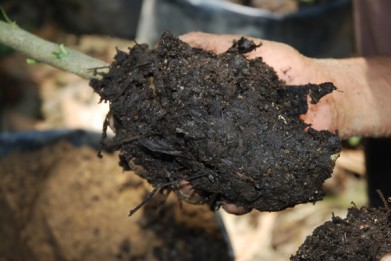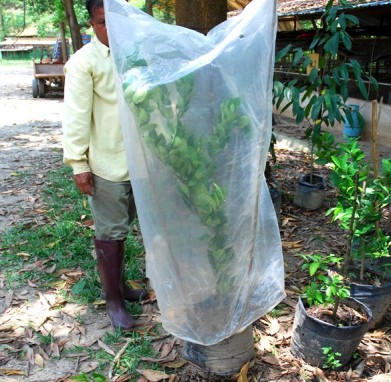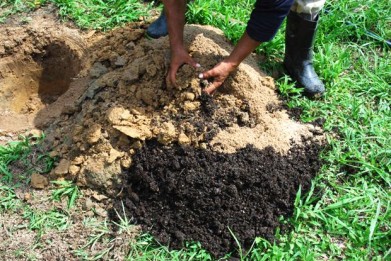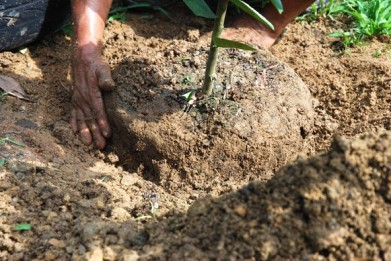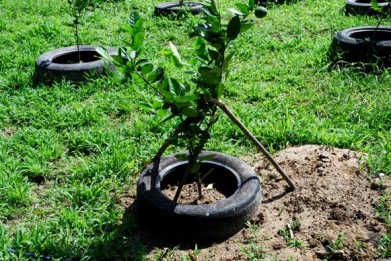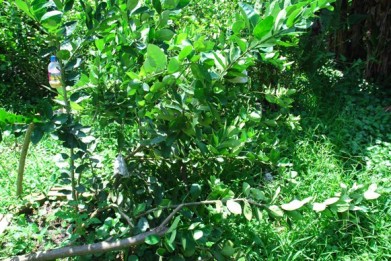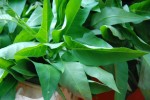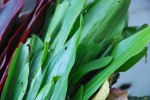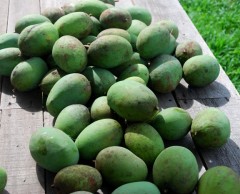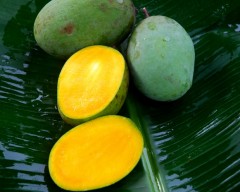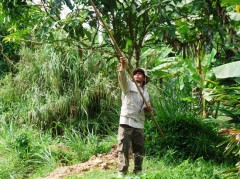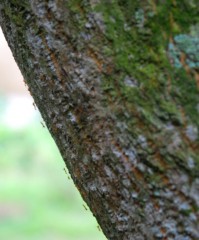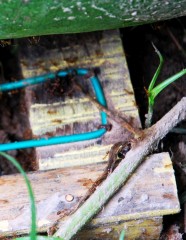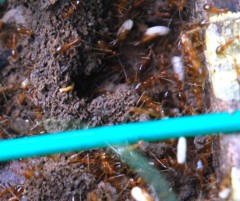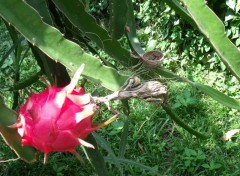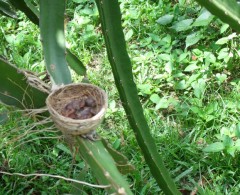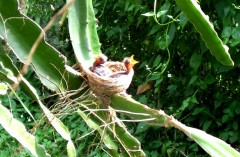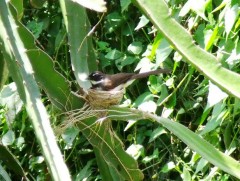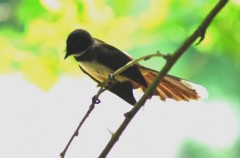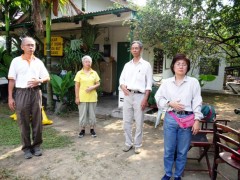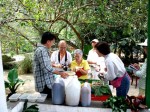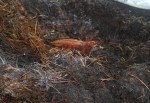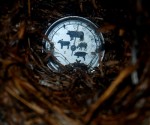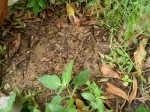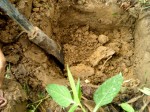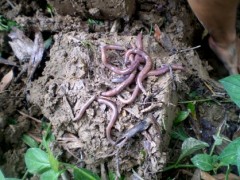Jul 04, 2017
Today at the Wild Farming Pilot #wildfarming
'Wild Farming' is a work-in-progress to mimic nature. On a vegetable plot, we will plant maybe 40% non-market plants, some with insect repellent properties, some that are just aromatic to confuse insects, etc., and 60% a mix of, or a variety of, market vegetables and plants. In our pilot plot here, the market vegetables are ridge gourd, brinjal, bird's eye chili, sweet corn and lady's fingers.
We are expecting some sweet corn next week; "GMO free some more" ![]()
Chilies should be plentiful next couple of weeks. Lady's fingers have started to produce. The terung has slowed a bit but we shall fix that with a compost dressing this couple of days. Over at the petola section, they are working overtime!


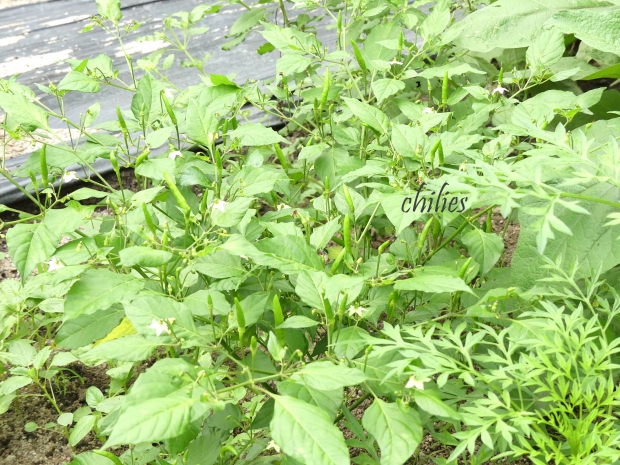


14:26 Posted in Nature Farming, Permaculture, Sustainable Farming, Wild Farming | Permalink | Comments (0) | Tags: wild farming, sustainable agriculture, organic farming
Apr 08, 2011
Marcotting II
We generally have good root formation in around 30 to 45 days for lemon trees and other limau-type trees.
Saw off, and dap some iodine on the cut
Wrap vermicast around the root ball
Plant in a polybag with a light, friable and loose soil mix. We like to add some sand and vermicast to our farm soil. Loose, light soil will encourage the roots to grow deeper.
Cover the plant with a plastic bag to prevent drying out. Remove when new leaves and branch shoots are noticeable. Once the new leaves and shoots are established, plant to soil.
The area where we are planting these citruses have heavy laterite soil. We generally dig a hole and then mix the laterite with sand and compost.
We mix the laterite with sand and vermicast or compost
Place the plant half inside the hole
A planted marcotted guava
We generally place an used tire over the spot and top up the soil mix as need be. The tire reduces weeds, and prevent leachate of compost and vermicast.
Support the young tree. Marcotted trees tend to be shallow rooted and care must be taken during windy monsoon seasons.
5 year old marcotted lemon tree falling over after a night of heavy rain and strong winds. Marcotted trees have no tap root so should be supported even when matured in windy zones.
12:37 Posted in Blog | Permalink | Comments (0) | Tags: marcotting, air layering, lemon, organic farming, permaculture
Mar 14, 2011
Permaculture At The Farm I
Here's some permanent agriculture (permaculture) features at the farm:
Alley cropping of napia grasses to reduce pressure on arable land for ruminants. By cultivating grasses we can raise up to 200 goats per acre of land versus around 15 here in Malaysia. We alley crop with nitrogen-fixing leguminous gliricidia septum. It may be necessary to fallow with leguminous cover crops after a couple of years. At the moment, we ferment chicken discards such as feathers, guts, etc. to produce a liquid fertiliser, and fertilise twice a year. So far, production of grass has been maintained, a good example of sustainability.
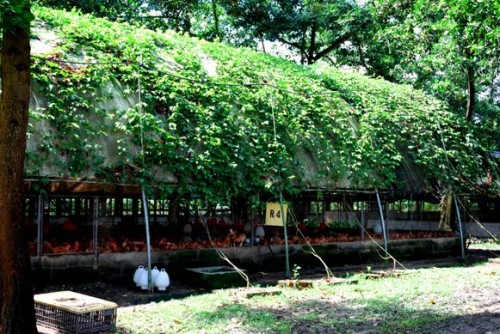
Passion (fruit) vines grow fast, and produce sufficient foliage to impart noticeable cooling. Sun-shading using plants is efficient, easy, with little maintenance needed, and have practically no running costs. Next, passiflora shades in the chicken fields; side effects - more insects and vitamin Cs for the chickens!
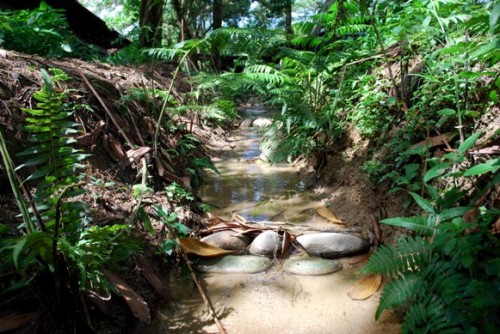
Earth drains permit infiltration of water and generally slows down run-offs. However, in our heavy monsoon downpours, earth drains need regular maintenance and may contribute to erosion.
A judicious mix of earth and concrete drains may be necessary, in addition to other water retention and diversion strategies.
Earth drains increase available planting spaces in small farms. Earth drains at our farm are income generating, producing a variety of crops - watercress, edible ferns, pandan leaves, arrowroots, and various edible taro tubers.
The picture shows the laying of low stone barriers across earth drains to slow down water flow and hence reducing erosion. They also allow for deeper, slower flowing sections enabling feeding and hence increasing the population of wild eels which are harvested.
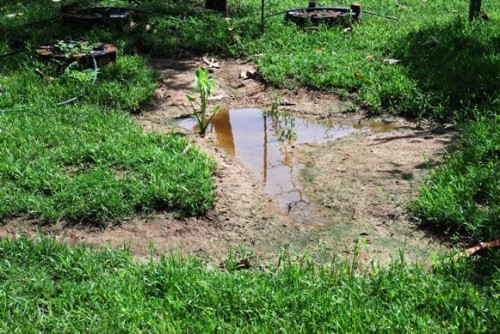
Shaping of land to create catchment areas to retain water, to slow down flow of rain water, and in the case in this picture, to reduce water-logged areas. In the process planting spaces are created for growing water loving vegetables - here, just planted watercress and arrowroot.
After a down pour, the land used to get soggy and difficult to work for days. With these catchment areas, the soggy areas are gone and the catchment area retains water for weeks (due to high water table) - good for planting income generating water loving vegetables.
12:03 Posted in Permaculture | Permalink | Comments (2) | Tags: permaculture, napia grass, sustainable agriculture, organic farming, natural sun-shading, passion fruits, swales, earth drains, retention ponds
Aug 19, 2010
Natural Flowering Enhancers
We use what's in the farm to make our own flowering enhancers. Our dragon fruits never stop flowering and producing fruits. Our durians can be fruiting two to three weeks before others.
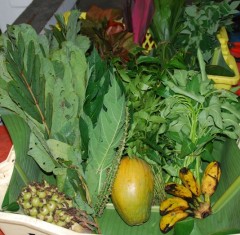



papaya 2.5
banana 2.5
Red Leaves 1.0
Kangkung young leaves 1.0
Acasia young leaves 1.0
Molasses 2.0
Quarry dust sprinkle
Put in a container until half full (or half empty, whichever). Leave for up to 60 days, covered loosely, before proceeding.
There are a few variations to use the above (which we shall call the Mother). One way is as follows:
Dilute adding 1 part filtered Mother, 1 part molasses to 20 parts water to make a Concentrate. Let the Concentrate sit for up to 7 days before diluting further required amount to use. Add one part Concentrate, one part molasses and 50 parts water for Spraying Dilution. It goes without saying you must always use unchlorinated water.
Do not spray direct from Concentrate on plants. They may wilt. Always spray diluted. Not recommended for ornamentals.
If you are using compost tea, add one part filtered Mother to 20 parts tea, and spray. Use only on fruit trees (including pitaya).
Email me direct if you encounter problems.
Notes:
1. You can find the acacia tree being grown along highways. You can use the young leaves from young trees. Acacia is an invasive, so don't plant it in your farm unless you have the patience to continually weed out the young trees.
2. Any red leaves will do.
17:45 Posted in Bio Nutrients | Permalink | Comments (6) | Tags: nature farming, organic farming, qi, qi farming, flowering enhancers, penggalak bunga
Jun 07, 2010
Nature Farming - Kuini
You don't find many kuini (mangifera odorata) in the market. Part of the reason is that the tree is not very productive as far as commercial farmers are concerned. For the same amount of fertiliser, pesticides and labour, the production is significantly less for the kuini tree as compared to other commercial hybrid mangoes.
Kuini trees in a row
Pak Din plucking the fruits
Another reason is that the weevils love kuini and losses can be high, unless one really go the 'overkill' path and spray pesticides copiously.
At DQ Farm we use nature to help us. And nature works 24/7 without rest.
Vicious red ants swarming entire trees from root to fruit, keeping the fruits free from weevils and other insects.
Red ants swarming a fallen fruit protecting it from insects:
buah macang buah kuini
masak sebiji dalam daun
mengapa begini hatiku ini
habis bulan berganti tahun
My translation:
the kuini the machang
fold one in leaves to ripen
this heart of mine, oh what's hidden
a year passes with each fading month
10:42 Posted in Nature Farming | Permalink | Comments (3) | Tags: nature farming, organic farming, kuini, mango farming, mangifera odorata
May 17, 2010
Proud Farmer I
Look At What Our Compost Did!!!
We grew a watermelon variety that normally ripens at around 2 to 3 kg (easier to sell, we thought).
Look at what our compost have done to the fruits:
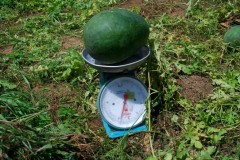
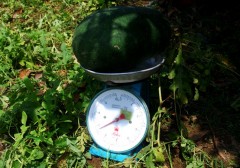
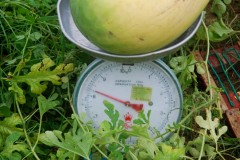

10:38 Posted in Blog | Permalink | Comments (0) | Tags: compost tea, bio nutrients, watermelon, organic fruits, organic farming
Apr 13, 2010
Organic Farming - Oasis For Birds
An organic farm is like an oasis to birds. At our farm we have counted close to 50 species. Foreign workers at our farm comment that there's no longer any necessity to keep them in cages as they are all around us and we don't even have to feed or water them! That's a valuable lesson they will take back with them after they finish their contract with us.
And the birds lost most of their fear for humans. They will nest anywhere; next to the kitchen, on pillars, inside a comb of bananas, or like the photos here, on a dragon fruit plant in broad daylight in plain view of passer-bys and vehicles :
Right next to a ripened dragon fruit.
A couple of hatchlings in a meticulously weaved cup with tidy, even rim.
The bird that made this cup is the Pied Fantail or Rhipidura Javanica Longicauda.
In our farm, they have grown used to being in close proximity to humans, but remain wild as nobody in the farm is allowed to feed the birds.
The Pied Fantail is distinguished from other Fantails by pale underparts with a contrasting blackish breast-band.
When annoyed, it gives a chit, cheet sound to distract you from its nest.
It lays a clutch of 2 eggs and is common throughout South East Asia.
Mum's back.
Close up (click on picture) of the Pied Fantail. Note the breast-band, and the barely noticeable white eye-brow.
Here's why they are named Fantail (click on pic for close-up).
18:04 Posted in Blog | Permalink | Comments (0) | Tags: organic farming, sustainable agriculture, birding
Jun 22, 2009
Workshop on Nature Q-Farming
We had a workshop on making bio nutrients and basics of Nature Q Farming on June 20th 2009. The workshop is meant for home food growers and not for commercial farmers. The objectives are to 1) introduce market gardening to urban dwellers to reduce the hold of commercial farmers over our lives, 2) to empower urban dwellers to take back some of the responsibility of producing healthy food for our children, and 3) to allow urban dwellers to have a source of income to offset increasing costs of living in the cities.
Participants were 'aligned' to the energy in the environment and taught how to harness the energy that is present, to enhance the energy and to incorporate the energy into the plants and vegetables that they are growing. By so doing, they give to the plants a part of their energy and in return the plants and microbes will multiply it many fold for them.

The field of energy around us.
Read 'The Field' by Lynne McTaggart.
For the first time, these 'die-hard' organic gardeners felt a living connection with the plants that they have been growing for years. We become a part of the plants and they become a part of us, in this cycle of passing of nutrients and living energy between one living organism to another; we are no longer 'eating' a plant instead we are sharing and exchanging living energy.
I can still remember the wonder on the face of one of the participants when he felt the microbes releasing energy at him. And I remember also the remark of another participant that he was wondering why he did not start panting after a fairly vigorous walk to some wild bamboo groves and back, as he was a heart patient.
An important part of Nature Q Farming is working with the plants and herbs and microbes that is in the environment.
Making brews of various friendly microbes to be used as intermediaries between us and the plants that we are growing.
18:11 Posted in Bio Nutrients | Permalink | Comments (5) | Tags: nature farming, organic farming, qi, qi farming
May 27, 2009
Carcasses - Compost 'em for Sustainability
The disposal of carcasses and animal wastes often pollutes the environment. In Malaysia, farms generally bury them or burn them.
At DQ, we compost them and return them to the soil as fertiliser and as soil amendment. We have innovated our own method of composting carcasses, after much trial and error, as follows:
Lay the carcasses and wastes in layers and between the layers, cover them with carbon material such as dried lallang, leaves, etc. We generally require the abdomen of all carcasses to be opened to prevent inadvertently creating anaerobic conditions from forming inside the carcasses which may result in the formation of toxins.
Lactobacillus is sprayed on the layers to speed up the heating process. Lactobacillus is a medium heat microbe and works well and fast at our ambient temperature of around 30 celcius. Within a day they will bring the temperature of the heap to 45 celcius for the thermophilics to take over.

With enough moisture and oxygen, actinomycetes will jump into action almost immediately breaking down the materials in the heap and giving the characterisitic "earth" smell to your compost at the end.
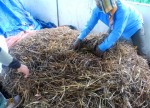
Cover up the pile neatly to retain the heat for the thermophilics to do their work thoroughly.
After a couple of days, the heat generated will be sufficient to cook an egg in a short while. Or to cook beef:
65 celcius - hot enough to cook beef.
The pile or heap should be turned a minimum of two times to ensure that as much of the material has gone through the heating process to destroy pathogens and even some toxins. At DQ this process will take 30 days.
After that, we introduce local composting earthworms to turn the compost to humus / vermicast. The composting earthworms ( eisenia fetida) works pretty fast, within 10 days they will have a few inches of vermicast for you to collect and use.
( Do not use imported earthworms as there are millions of microbes in the guts of earthworms and you may be introducing 'aliens' to our environment).

Beautiful black humus in just 40 days. The end result is a microbes-rich fertiliser suitable to be used as a soil fertiliser, as an amendment or as a foliar spray. We use this humus to build up sandy soil, as an anti-fungal, as fertiliser and generally to return to the soil what has been taken from it.
If you are already applying some other organic fertiliser, the addition of humus made the DQ way at a rate of 100kg per acre to acre and a half will see a 10 to 15 percent improvement in yields. And that's 10 to 15% straight to the bottom line as the inputs used are generally free!
17:23 Posted in Chickens | Permalink | Comments (5) | Tags: compost, carcasses, sustainable agriculture, organic farming
Apr 08, 2009
Earthworms - Count 'Em, Jimmy Loke
Jimmy Loke, a gentleman farmer came visiting and expressed the hope that I can share more knowledge with him and his brother. Well, the first thing is, count the earthworms in your farm, Jimmy.
Early in the morning, when the earthworms come out to feed, count them.
Mark out a foot square.
Dig out the foot cube of soil. Do it fast as earthworms are sensitive to vibrations and many will make off.
Count 'em.
In DQ Farm, we have up to 60 earthworms per cubic foot of soil. On a good day, it can reach 100. In some Western countries they are happy with 10 - 15.
And here in Malaysia, with such good soil, we are dumping synthetic fertilisers and stuff to kill them off.
So Jimmy, count your earthworms, and if they are lacking, build them up to at least 40 before we talk about organic farming.
20:04 Posted in Blog | Permalink | Comments (0) | Tags: earthworms, organic farming










